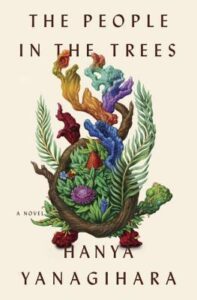By A.J. Griffiths-Jones
The powerful debut novel by American novelist Yanagihara, this book really packs a punch. The author stated that her work was inspired by the true story of physician and medical researcher Daniel Carleton Gajdusek, who was revered by the scientific community before being accused of child molestation. Fictional protagonist Dr Abraham Norton Perina is similarly prosecuted.
 A great part of the novel is made up of the fictional memoirs of Perina, who discovers a turtle with life-prolonging qualities on the islands of Ivu’ivu and U’ivu. Having been brought up in smalltown Indiana, the young medical student is approached by a team who are setting off on an anthropological mission and need a doctor to accompany them to the remote islands.
A great part of the novel is made up of the fictional memoirs of Perina, who discovers a turtle with life-prolonging qualities on the islands of Ivu’ivu and U’ivu. Having been brought up in smalltown Indiana, the young medical student is approached by a team who are setting off on an anthropological mission and need a doctor to accompany them to the remote islands.
Keen to be part of the research, Perina accepts the position and soon finds himself setting off to the jungle with the team’s leader, Paul Tallent, and a rather offensive woman named Esme Duff.
On arrival the trio are met by native guides who lead them to the depths of the forest, which is where Tallent reveals that they are there to study the legend of a lost tribe who have been gifted with eternal life.
It soon becomes apparent that Norton has taken a deep dislike to Esme and avoids interaction with her, preferring to conduct his own agenda and also to confer with Tallent without the woman’s input. This makes for a strained relationship between the team, although with the help of their native guides progress is fairly prompt in connecting with the ‘Dreamers’ whom they sought out.
Tallent discovers that this lost civilisation has the mark of a turtle on them and, after conducting experiments, reaches the conclusion that some of the tribesmen and women are well over one hundred years old.
The researchers are eventually allowed to observe the daily lives of this unusual people which includes some rather disturbing cultural differences.
It is after this event that the group are invited to celebrate the village chief’s 60th birthday, where he eats a turtle, causing the doctor to realise that the Dreamer’s longevity and the sea creature are connected. It is the trapping and killing of a turtle by Perina that sets off a series of events that will eventually condemn the people of U’ivu.
As Norton Perina enjoys success with his medical paper, proving that the turtle flesh can prolong life, the turtle itself is eventually hunted to extinction by pharmaceutical companies and the island becomes colonised by outsiders, endangering the tribe that Paul Tallent was so insistent upon protecting.
 Realising his great mistake, Norton returns to the people of U’ivu and starts to adopt abandoned children in large numbers as a kind of self-penance, including the boy, Victor, with whom he had an encounter.
Realising his great mistake, Norton returns to the people of U’ivu and starts to adopt abandoned children in large numbers as a kind of self-penance, including the boy, Victor, with whom he had an encounter.
With his home now overrun by teenagers, Norton struggles to take control and when Victor makes accusations to Norton’s brother, Perina finds himself imprisoned.
The narrative of this book is based on Perina’s memoirs written from his cell, encouraged by colleague Dr. Ronald Kubodera who writes footnotes to clarify and justify Norton’s actions. The story culminates in 2000, where Kubodera writes that he and Perina have escaped from the parole officer, with an added note that he feels deep guilt at having omitted a portion of the researcher’s memoirs.
This is an extremely unnerving story, but one which deserves time to absorb the intricate details as it stands out as an exceptional piece of writing on the author’s part, with some visually descriptive prose and complex characters. There’s a lot to take in, but as the intensity of Norton Perina’s situation builds, so does the reader’s fascination with the concept of a lost tribe and the discovery of an unknown civilisation.
There are dark undertones to the book, but it is cleverly constructed with the third-party footnotes acting as a guide. One of the most remarkable points to note is that this is the writer’s first book, which is an astounding achievement as undertaking such a complex and sensitive topic is no easy feat. A book that is definitely not for the faint-hearted but one which will stay with the reader and create pause for thought.